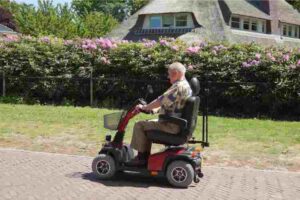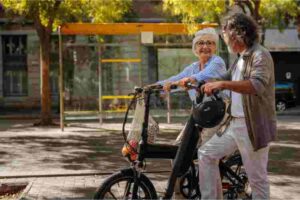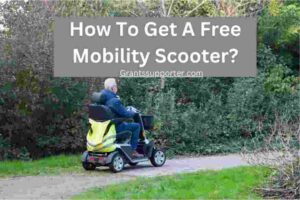Have you ever found yourself or a loved one needing a mobility scooter, but the high cost put it out of reach? Mobility scooters are essential for many, providing independence and improved quality of life. This comprehensive guide will explore various ways to obtain a free mobility scooter for seniors.
Whether it’s through government assistance, non-profit organizations, or community efforts, we’re here to help you navigate these options. Let’s delve into the world of mobility scooters and discover how you can acquire one without a financial burden.
What Is A Free Mobility Scooter?
A free mobility scooter for seniors is an electric personal transporter used as a mobility aid for people with physical impairment, mostly auxiliary to a powered wheelchair but configured like a motorscooter.

When motorized they function as micro-mobility devices and are commonly referred to as powered vehicles/scooters, or free electric scooters for the disabled.
Non-motorized mobility scooters are less common but are intended for the estimated 60% of wheelchair users who have at least some use of their legs.
Whilst leg issues are commonly assumed to be the reason for using scooters, the vehicles are used by those with a wide range of conditions from spinal injuries to neurological disorders.
Mobility scooters differ from power wheelchairs in that they are usually cheaper, somewhat easier to move across uneven ground, and are more customizable.
These scooters are built for people who have trouble walking or getting around but don’t always need a power wheelchair.
They are also used by people who do need a powerchair for intermediate distances or extended standing, or those not permitted to drive cars for medical reasons.
How Much Does A Mobility Scooter Cost?
The cost of a mobility scooter in the USA can vary significantly depending on several factors:
1. Type of Scooter:
- 3-wheel scooters: Generally cheaper, starting around $1,500 for basic models and reaching up to $5,000 for feature-rich options.
- 4-wheel scooters: Tend to be pricier, ranging from $3,000 for basic models to $10,000+ for heavy-duty or enclosed models.
2. Brand and Features:
- Popular brands: Like Pride Mobility, Golden Technologies, and Drive Medical, typically charge more than lesser-known brands.
- Features: Additional features like advanced electronics, suspension systems, and comfortable seating can significantly increase the price.
3. New vs. Used:
- Used scooters: These can be a much cheaper option, sometimes available for 50% or less of the original price. However, ensure they’re in good condition and properly maintained.
4. Location and Availability:
- Prices may differ: Depending on your city or state, due to factors like taxes, transportation costs, and local demand.
Here’s a quick breakdown of price ranges:
- Basic 3-wheel scooter: $1,500 – $3,000
- Mid-range 3-wheel scooter: $3,000 – $5,000
- Premium 3-wheel scooter: $5,000 – $7,000
- Basic 4-wheel scooter: $3,000 – $5,000
- Mid-range 4-wheel scooter: $5,000 – $8,000
- Premium 4-wheel scooter: $8,000 – $10,000+
How To Get A Free Mobility Scooter?
Mobility scooters can be quite expensive, with prices ranging from a few hundred to several thousand dollars. This cost can be prohibitive for many, making free or subsidized options vital.

Obtaining a free mobility scooter for seniors can significantly improve the quality of life for individuals facing mobility challenges.
While it may not always be easy, there are various avenues you can explore to acquire a mobility scooter without a hefty price tag.
Here’s a detailed guide on different approaches to securing a free mobility scooter for seniors:
1. Contact Local Nonprofits and Charities:
Many organizations dedicated to assisting individuals with mobility challenges operate at the local level. Nonprofits and charities often have programs that provide free or discounted mobility scooters. Reach out to these organizations, explain your situation, and inquire about any available assistance.
2. Government Assistance Programs:
Government programs such as Medicare or Medicaid may cover the cost of mobility scooters in certain situations. Contact your local social services or health department to understand the eligibility criteria and application process for government assistance.
3. Health Insurance:
Some private health insurance policies include coverage for mobility aids, including scooters. Check with your health insurance provider to determine the extent of coverage and the steps to follow in obtaining a mobility scooter through your insurance.
Medicare Coverage for Durable Medical Equipment (DME): Check with your doctor and insurance provider to determine if your specific medical condition qualifies for coverage of a mobility scooter under Medicare’s DME program.
4. Veteran Services:
Veterans may have access to mobility scooters through programs offered by the Department of Veterans Affairs (VA). If you are a veteran, explore VA programs and inquire about eligibility criteria and application procedures.
Paralyzed Veterans of America: Explore their website or contact local chapters to inquire about potential programs or assistance for veterans needing mobility scooters.
5. Online Platforms and Forums:
Utilize online platforms, forums, and community groups where individuals may donate or sell used mobility scooters at a reduced cost. Be cautious and ensure the legitimacy of the sources to avoid potential scams.
6. Community Fundraising:
Crowdfunding has become an effective way to raise funds for various needs, including mobility scooters. Create a compelling campaign on crowdfunding platforms, share your story, and seek support from friends, family, and the community.
7. Medical Equipment Loan Closets:
Some communities have organizations that operate medical equipment loan closets. These entities lend out free scooters for seniors and other medical equipment either for free or at a low cost. Inquire about the availability of such services in your area.
8. Local Churches and Religious Organizations:
Religious organizations and local churches often extend aid to community members in need. Contact them to inquire about any assistance programs or resources they may have for obtaining a free mobility scooter for seniors.
9. Ask for Donations:
Reach out to local businesses, philanthropists, or community members who may be willing to donate towards your need for a mobility scooter. Clearly articulate your situation and explain how their contribution could make a positive impact.
10. Research Local Resources:
Explore local community centers, senior centers, and disability support groups for additional opportunities. These resources may provide valuable information on programs or initiatives that can assist you in acquiring a mobility scooter.
By exploring these avenues and being proactive in seeking assistance, you increase your chances of obtaining a free or low-cost mobility scooter that can enhance your independence and mobility.
How To Apply For A Free Mobility Scooter?
Applying for a free mobility scooter for seniors involves a systematic approach. Begin by gathering essential information, including a detailed medical report and financial details.
Identify potential sources, such as government schemes, charitable organizations, and manufacturer programs.
Complete accurate application forms, attach necessary documents, and submit them following program guidelines.
Stay informed and, if needed, inquire about the status of your application. Participate in assessments if required, cooperating fully to demonstrate your genuine need.
Await the decision, and upon approval, follow the provided instructions for scooter delivery or pickup.
This comprehensive process ensures that individuals with mobility challenges can access the support they need for improved independence and quality of life.
1. Gather Essential Information:
- Medical documentation: Obtain a detailed medical report from your doctor or healthcare professional, clearly stating your disability, mobility limitations, and how a scooter would improve your quality of life.
- Financial details: If applying for government or charitable programs, gather proof of income, assets, and any existing disability benefits or pensions.
- Contact information: Have your name, address, phone number, and email address ready.
2. Identify Potential Sources:
- Government schemes: Contact the Department of Empowerment of Persons with Disabilities (DEPwD) or your local Social Welfare Department to inquire about applicable programs and eligibility criteria.
- Charitable organizations: Reach out to Mobility India, Rotary Clubs, Lions Clubs, or other local charities that offer mobility assistance.
- Manufacturer programs: Check if any mobility scooter manufacturers have special programs or giveaways in your region.
3. Complete Application Forms:
- Obtain application forms: Each program or organization will have its specific application form. Request these forms either online, in person, or by mail.
- Fill out forms accurately: Provide all required information, including medical documentation, financial details, and contact information.
- Attach necessary documents: Include copies of medical reports, financial statements, and other relevant supporting documents.
4. Submit Applications and Follow-Up:
- Submit forms as instructed: Follow the guidelines for each program regarding submission methods (online, in person, or by mail).
- Stay informed: Keep track of application deadlines and response timelines.
- If you haven’t heard back within a reasonable timeframe, reach out to the relevant organizations to inquire about the status of your application.
5. Participate in Assessments (if applicable):
- Some programs: May require an in-person assessment to evaluate your mobility needs and suitability for a scooter.
- Cooperate fully: Provide accurate information and demonstrate your genuine need for the scooter.
6. Await Decision and Delivery:
- Programs will review : Your application and supporting documents to determine eligibility.
- Approval: If approved, you’ll be notified of the next steps for receiving the scooter.
- Delivery: The free electric scooters for the disabled may be delivered to your home or require pickup from a designated location.
Benefits Of Mobility Scooters For Seniors And The Disabled
Mobility scooters can be game-changers for seniors and individuals with disabilities, offering a multitude of benefits that go beyond simply getting from point A to point B. Here’s a closer look at how these incredible devices can empower and enrich lives:

1. Enhanced Independence and Freedom:
- Imagine being able to navigate your own path, run errands, and visit loved ones without relying on others for assistance.
- Mobility scooters grant seniors and the disabled a newfound sense of independence, allowing them to regain control over their daily routines and participate in activities they might have previously considered impossible.
2. Improved Physical and Mental Wellbeing:
- Regular use of a mobility scooter can lead to increased physical activity, promoting better circulation, muscle strength, and overall fitness.
- This, in turn, can boost energy levels, combat fatigue, and reduce the risk of falls and other health complications.
- Furthermore, the newfound independence and social interaction facilitated by free scooters for seniors can significantly improve mental well-being, alleviating feelings of isolation and depression.
3. Increased Participation and Socialization:
- Mobility scooters enable seniors and the disabled to join in on outings, community events, and social gatherings they might have otherwise missed.
- This fosters a greater sense of belonging, combats loneliness, and provides opportunities for meaningful social interaction, all of which are crucial for mental and emotional well-being.
4. Reduced Pain and Fatigue:
- For individuals with chronic pain or limited mobility, walking even short distances can be exhausting and painful.
- Mobility scooters alleviate this burden, allowing them to conserve energy and reduce pain levels, thereby improving their overall quality of life and enabling them to participate in activities they enjoy.
5. Access to a Wider World:
- Mobility scooters open doors to previously inaccessible places, such as museums, parks, and even certain historical landmarks.
- This newfound ability to explore and experience new environments can be incredibly liberating and fulfilling for seniors and the disabled, enriching their lives with fresh perspectives and opportunities.
- Remember, choosing the right mobility scooter is crucial for maximizing its benefits. Consulting with a healthcare professional or occupational therapist can help you determine the most suitable model based on your individual needs and preferences.
- With careful planning and the right device, free scooters for seniors can become invaluable tools for seniors and the disabled, paving the way for a more independent, active, and fulfilling life.
Conclusion
While the cost of mobility scooters can be high, there are many avenues to explore for obtaining one for free or at a reduced cost. By exploring government programs, reaching out to non-profits, or utilizing community resources, the dream of regaining mobility and freedom with free mobility scooter for seniors can become a reality.
This guide aims to provide the necessary information to help you or your loved one take this important step towards enhanced mobility and a better quality of life.
